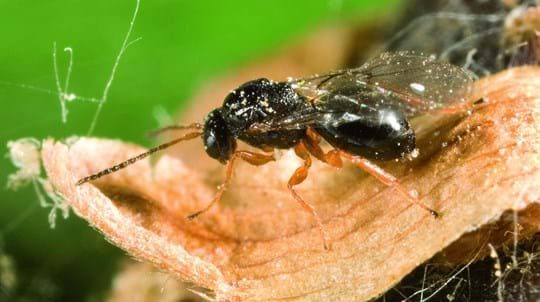
Pests and diseases
Oriental Chestnut Gall Wasp
Newly introduced pest producing galls on sweet chestnuts.
Observatree volunteer
It was quite exciting to get my first proper call to action when it was reported that Oriental Chestnut Gall Wasps (OCGW) had been found in Kent. Obviously it wasn’t good that another tree pest had arrived in the UK, but I set out looking at trees with renewed purpose. There aren’t many sweet chestnut trees around St Albans but people know where they are as they are one of the only wild trees around providing a free harvest.
I immediately thought of a short row of sweet chestnut trees on a main road I often cycle past. You know what it’s like, time is always short, so on the way back from a swim I persuaded my daughter, Hannah, to stop off with me for a moment to inspect the trees. She stood there whilst I started at one end of the row, peering up into the canopy, looking for puckered leaves and distinctive galls. It took a little while as there are lots of leaves on a sweet chestnut tree and Hannah began to get bored.
What followed was the kind of conversation normally heard on a comedy show:
“What are you looking for Mum?”
“Oriental chestnut gall wasps” (me peering intently) “well, not the wasps, but the galls they make.”
“What do they look like?”
“Smooth, a bit plastic, like a green or pinkish blob on a wrinkled leaf.” (more intent peering)
“Like this one?”
I looked over to see that Hannah had just reached her hand up and pulled down a twig with leaves showing the unmistakable OCGW galls. Just like that. She’d barely even glanced at another leaf."
I took photos and submitted a Tree Alert report. Whilst I was certain that Hannah had found OCGW galls, I was quite sure that it was being found all over and so what we had discovered wasn’t very exceptional. I started to change my mind once I began receiving numerous urgent phone calls from the Forestry Commission. The speed at which they went to look at the infested trees started to bring the importance of the discovery home. Receiving an email saying that the outbreak “had been discussed by the minister” blew my mind.
On my next cycle back from the pool I found the main road fully shut with a sign explaining that ‘emergency highway maintenance’ was taking place. So I mounted the pavement and cycled past the workmen who were shredding the last remains of the entire row of sweet chestnut trees.
I hope that Hannah’s sharp eyes will protect other local sweet chestnut trees, but only time will tell.
1. How long do ‘gall forming’ symptoms last?
This depends where the gall is formed. The majority of galls found in Kent were found on the foliage which drops in the autumn or possibly earlier. In Italy galls often form at the base of the petiole (leaf stem) and become woody. They can remain attached to the tree for a few years. Only a couple of last year’s woody galls have been found in Kent.
2. What colour are the galls as they develop?
The galls are green while they develop at bud burst (from March onwards) and most turn reddish as they mature by June. The galls gradually dry out and turn brown over the summer and leaves may be dropped prematurely.
3. After the wasp emerges, is there anything left behind that leaves an indication of their presence?
Old galls will dry out, harden, turn brown and shrink. However galls that have been on foliage are likely to drop off the tree.
4. Can I get stung?
The wasp does not sting or pose any other risk to human health or to pet animals and livestock."